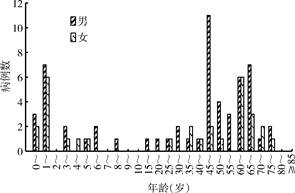
扩展功能
文章信息
- 代培芳, 田晓东, 赵俊英, 董海原, 程璟侠
- DAI Pei-fang, TIAN Xiao-dong, ZHAO Jun-ying, DONG Hai-yuan, CHENG Jing-xia
- 山西省2020年黑热病流行特征分析
- Epidemiological characteristics of visceral leishmaniasis in Shanxi province, China, 2020
- 中国媒介生物学及控制杂志, 2022, 33(3): 405-408
- Chin J Vector Biol & Control, 2022, 33(3): 405-408
- 10.11853/j.issn.1003.8280.2022.03.017
-
文章历史
- 收稿日期: 2021-11-26
黑热病是由趋内脏的利什曼原虫寄生于人体的淋巴-巨噬细胞系统所引起的一种地方性传染病[1-2],以白蛉为传播媒介[3-4],在世界范围内广泛流行。新中国成立初期,黑热病在我国长江以北的山东、河南等16个省流行,经大规模防治,20世纪60年代已基本消除该病[5-6]。但在新疆、甘肃、四川、陕西、山西和内蒙古等6省(自治区)局部地区仍持续有病例报告[5, 7]。我国黑热病大体分为人源型、犬源型和野生动物源型3种类型,山西省属于犬源型黑热病流行区。2017年以来,山西省黑热病报告病例数逐年攀升,2019-2020年报告病例数位居全国第一,黑热病疫情防控形势严峻紧迫。本文对2020年山西省的黑热病流行特征进行分析,旨在为全省的黑热病防控提供参考依据。
1 材料与方法 1.1 数据来源数据资料来源于中国疾病预防控制信息系统传染病报告信息管理系统,2020年1月1日至12月31日山西省各县(区)报告的黑热病临床诊断和确诊的本地病例。所有病例均为按发病时间统计的终审病例。
1.2 统计学分析采用Excel 2010软件进行数据整理和作图,SPSS 18.0软件对不同地区报告病例数的年龄组间差异进行单因素方差分析,P < 0.05为差异有统计学意义。
2 结果 2.1 流行概况山西省2020年报告黑热病病例87例,年发病率为0.23/10万,较2019年增加85.11%,无死亡病例;实验室确诊病例占50.57%,临床诊断病例占49.43%。
2.2 时间分布除12月外,其他月份均有病例报告;1-7月报告病例数逐渐增多,5、7月为高峰期,7个月共计报告病例65例,占全年报告病例的74.71%;8-11月共计报告病例22例,占全年报告病例的25.29%。见图 1。

|
| 图 1 2020年山西省黑热病报告病例时间分布 Figure 1 Temporal distribution of visceral leishmaniasis cases reported in Shanxi province, 2020 |
| |
报告病例分布于全省6个市,发病率由高到低分别为阳泉(68例)、长治(7例)、临汾(6例)、运城(3例)、太原(2例)和晋中市(1例),发病率分别为5.78/10万、0.20/10万、0.13/10万、0.06/10万、0.04/10万和0.03/10万。阳泉市病例数最多,占全省报告病例数的78.16%。
2020年全省黑热病有18个发病县(区),发病率 > 1/10万的县(区)有平定县(8.95/10万)、阳泉市郊区(6.49/10万)、阳泉市城区(3.50/10万)、阳泉市矿区(3.16/10万)、大宁县(1.49/10万)和襄垣县(1.43/10万)6个县(区),占报告病例数的80.46%。见表 1。

|
2020年全省黑热病报告病例男性57例,女性30例,男女性别比例为1.90∶1。各年龄组均有病例报告,发病年龄最小为7月龄,最大为78岁。5岁以下年龄组发病数占25.29%(22/87),≥60岁年龄组占32.18%(28/87),40~59岁发病人群占26.44%(23/87),其他年龄组共占16.09%(14/87)(图 2)。农民为主要发病人群,占总病例数的43.68%(38/87),其次为散居儿童,占26.44%(23/87),家务及待业人员占12.64%(11/87),工人、离退等5类人群共占17.24%(15/87)。
以阳泉市平定县(31例)、阳泉市郊区(19例)、阳泉市其他县(区)(18例)、山西省其他县(区)(19例)分析发病年龄组间差异,经单因素方差分析,不同地区报告病例在年龄组间差异有统计学意义(F=15.559,P < 0.001)。

|
| 图 2 2020年山西省黑热病报告病例年龄、性别分布 Figure 2 Age and sex distribution of visceral leishmaniasis cases reported in Shanxi province, 2020 |
| |
2004-2016年山西省黑热病处于较稳定的低水平流行阶段[8],2017-2020年呈现较为明显的增长趋势,2017年本地病例为18例,2018年增长到37例,2019年达到52例[9],2020年达到87例,部分县(区)已成为全国主要流行县(区)[10]。报告病例县(区)分布呈现扩张趋势[11-12],一些历史流行区复燃,2020年全省发病县(区)增至18个,成为全国犬源型黑热病流行县(区)最多的省份。
已有文献报道,我国犬源型黑热病发病高峰在4-5月[8-12],甘肃[13]、四川[14-15]和陕西省[16]黑热病发病高峰从3月到9月有所不同但有时间重叠;山西省是全国犬源型黑热病发病地区,报告病例在4-7月为最多,占全年病例数的48.27%,发病时间分布与全国犬源型黑热病发病时间基本一致。
黑热病报告病例一般男性多于女性,在犬源型黑热病流行区更为明显,全国犬源型黑热病病例男女性别比为1∶0.5~1∶0.6[8, 10-12, 17],甘肃、陕西、四川省报告的病例数男性多于女性,2010-2019年山西省累计报告病例男女性别比为2.33∶1[9],2020年仍是男性远高于女性,结合发病年龄分析,男女病例数的差别主要在45~60岁,这可能与成年男性较多参与野外工作或活动有密切关系。
2005-2019年我国犬源型黑热病流行区主要发病人群是10岁以下儿童,农民和学龄前儿童是高发病人群[8, 10-12];甘肃[13]、四川[14-15]、陕西省[16]等犬源型黑热病流行区发病人群以学生、儿童及农民为主。山西省2010-2019年发病人群以散居儿童和农民为主[9],分别占41.13%和28.37%,2020年山西省发病人群以农民和散居儿童为主,年龄主要集中在 < 5岁、≥60岁和40~59岁人群,发病人群年龄与职业分布和陕西省及近年全国犬源型黑热病流行区情况相似。
2017年以来,阳泉市成为山西省黑热病的高发地区,发病病例占全省60%以上[9],所辖5个县(区)均有报告病例,2019和2020年阳泉市郊区、平定县更是成为全国黑热病主要流行县(区)。开展以黑热病媒介白蛉为主要防治目标的爱国卫生清理工作,加强各级医疗机构对黑热病的诊疗培训,广泛开展黑热病防治宣传,全社会、全人群防控措施的持续有效实施,必将取得黑热病防控有效成果。
利益冲突 无
| [1] |
Alvar J, Yactayo S, Bern C. Leishmaniasis and poverty[J]. Trends Parasitol, 2006, 22(12): 552-557. DOI:10.1016/j.pt.2006.09.004 |
| [2] |
World Health Organization. Control of the leishmaniasis[R]. Geneva: WHO, 2010: 5-12.
|
| [3] |
Desjeux P. Leishmaniasis: Public health aspects and control[J]. Clin Dermatol, 1996, 14(5): 417-423. DOI:10.1016/0738-081X(96)00057-0 |
| [4] |
Bates PA. Transmission of Leishmania metacyclic promastigotes by phlebotomine sand flies[J]. Int J Parasitol, 2007, 37(10): 1097-1106. DOI:10.1016/j.ijpara.2007.04.003 |
| [5] |
管立人, 瞿靖琦, 柴君杰. 中国利什曼病的现状和对开展防治工作的若干建议[J]. 地方病通报, 2000, 15(3): 49-53. Guan LR, Qu JQ, Chai JJ. Leishmaniasis in China-present status of prevalence and some suggestions on its control[J]. Endem Dis Bull, 2000, 15(3): 49-53. DOI:10.13215/j.cnki.jbyfkztb.2000.03.023 |
| [6] |
王兆俊, 吴征鉴, 何凯增. 1960年来我国黑热病防治研究工作的进展[J]. 中国寄生虫学与寄生虫病杂志, 1983, 1(2): 65-73. Wang ZJ, Wu ZJ, He KZ. Advances in investigations and studies on Kala-azar in China since 1960[J]. Chin J Parasitol Parasit Dis, 1983, 1(2): 65-73. |
| [7] |
郑灿军, 薛垂召, 伍卫平, 等. 我国2005-2015年黑热病报告病例流行特征分析[J]. 中华流行病学杂志, 2017, 38(4): 431-434. Zheng CJ, Xue CZ, Wu WP, et al. Epidemiological characteristics of Kala-azar disease in China, during 2005-2015[J]. Chin J Epidemiol, 2017, 38(4): 431-434. DOI:10.3760/cma.j.issn.0254-6450.2017.04.004 |
| [8] |
韩帅, 伍卫平, 薛垂召, 等. 2004-2016年中国内脏利什曼病疫情分析[J]. 中国寄生虫学与寄生虫病杂志, 2019, 37(2): 189-195. Han S, Wu WP, Xue CZ, et al. Endemic status of visceral leishmaniasis in China from 2004 to 2016[J]. Chin J Parasitol Parasit Dis, 2019, 37(2): 189-195. DOI:10.12140/j.issn.1000-7423.2019.02.013 |
| [9] |
郑玉华, 白永飞, 帖萍, 等. 2010-2019年山西省人群内脏利什曼病流行特征分析[J]. 中国寄生虫学与寄生虫病杂志, 2021, 39(3): 352-358. Zheng YH, Bai YF, Tie P, et al. Epidemiological characteristics of visceral leishmaniasis in Shanxi province, 2010-2019[J]. Chin J Parasitol Parasit Dis, 2021, 39(3): 352-358. DOI:10.12140/j.issn.1000-7423.2021.03.009 |
| [10] |
周正斌, 李元元, 张仪, 等. 2019年我国内脏利什曼病疫情分析[J]. 中国寄生虫学与寄生虫病杂志, 2020, 38(5): 602-607. Zhou ZB, Li YY, Zhang Y, et al. Prevalence of visceral leishmaniasis in China in 2019[J]. Chin J Parasitol Parasit Dis, 2020, 38(5): 602-607. DOI:10.12140/j.issn.1000-7423.2020.05.012 |
| [11] |
周正斌, 李元元, 张仪, 等. 2015-2018年我国内脏利什曼病疫情分析[J]. 中国寄生虫学与寄生虫病杂志, 2020, 38(3): 339-345. Zhou ZB, Li YY, Zhang Y, et al. Prevalence of visceral leishmaniasis in China during 2015-2018[J]. Chin J Parasitol Parasit Dis, 2020, 38(3): 339-345. DOI:10.12140/j.issn.1000-7423.2020.03.013 |
| [12] |
周正斌, 李元元, 张仪, 等. 2018年全国内脏利什曼病疫情分析[J]. 中国寄生虫学与寄生虫病杂志, 2020, 38(2): 175-180, 187. Zhou ZB, Li YY, Zhang Y, et al. Prevalence of visceral leishmaniasis in China in 2018[J]. Chin J Parasitol Parasit Dis, 2020, 38(2): 175-180, 187. DOI:10.12140/j.issn.1000-7423.2020.02.007 |
| [13] |
余大为, 丁国武, 格鹏飞, 等. 2005-2014年甘肃省内脏利什曼病流行情况的回顾性分析[J]. 中国寄生虫学与寄生虫病杂志, 2015, 33(3): 208-211. Yu DW, Ding GW, Ge PF, et al. A retrospective analysis on the prevalence of visceral leishmaniasis in Gansu province during 2005-2014[J]. Chin J Parasitol Parasit Dis, 2015, 33(3): 208-211. |
| [14] |
张富南, 李国茹, 雷杨, 等. 四川省1984-2005年黑热病发病情况分析[J]. 中国病原生物学杂志, 2007, 2(1): 79-80. Zhang FN, Li GR, Lei Y, et al. Analysis on leishmaniasis in Sichuan province from 1984 to 2005[J]. J Pathogen Biol, 2007, 2(1): 79-80. DOI:10.13350/j.cjpb.2007.01.031 |
| [15] |
陈闯, 丁岚利, 张富南. 四川省山丘型黑热病的人群分布[J]. 预防医学情报杂志, 2013, 29(7): 553-557. Chen C, Ding LL, Zhang FN. Population distribution of leishmaniasis in mountainous areas of Sichuan province[J]. J Prev Med Inf, 2013, 29(7): 553-557. |
| [16] |
马琳, 曹磊, 邱琳, 等. 陕西省黑热病流行病学特征及时空聚类分析[J]. 中国公共卫生, 2018, 37(7): 1021-1025. Ma L, Cao L, Qiu L, et al. Prevalence characteristics and space-time clustering of leishmaniasis in Shaanxi province[J]. Chin J Public Health, 2018, 37(7): 1021-1025. DOI:10.11847/zgggws1115469 |
| [17] |
赵树青, 李中杰, 张倩, 等. 2005-2012年全国不同年龄组人群内脏利什曼病流行特征[J]. 中华传染病杂志, 2014, 32(8): 492-495. Zhao SQ, Li ZJ, Zhang Q, et al. Analysis of epidemiologic features of visceral leishmaniasis in different age groups in China from 2005 to 2012[J]. Chin Infect Dis, 2014, 32(8): 492-495. DOI:10.3760/cma.j.issn.1000-6680.2014.08.011 |
 2022, Vol. 33
2022, Vol. 33




